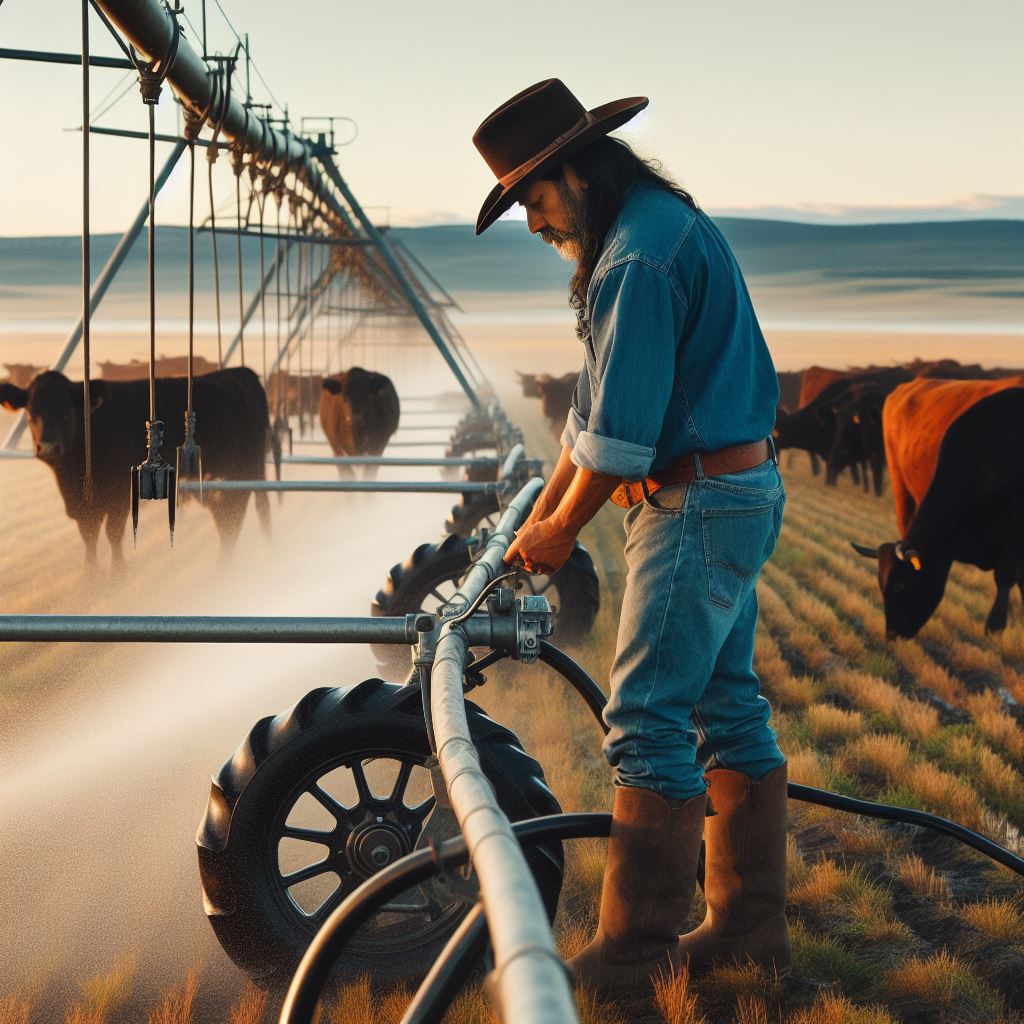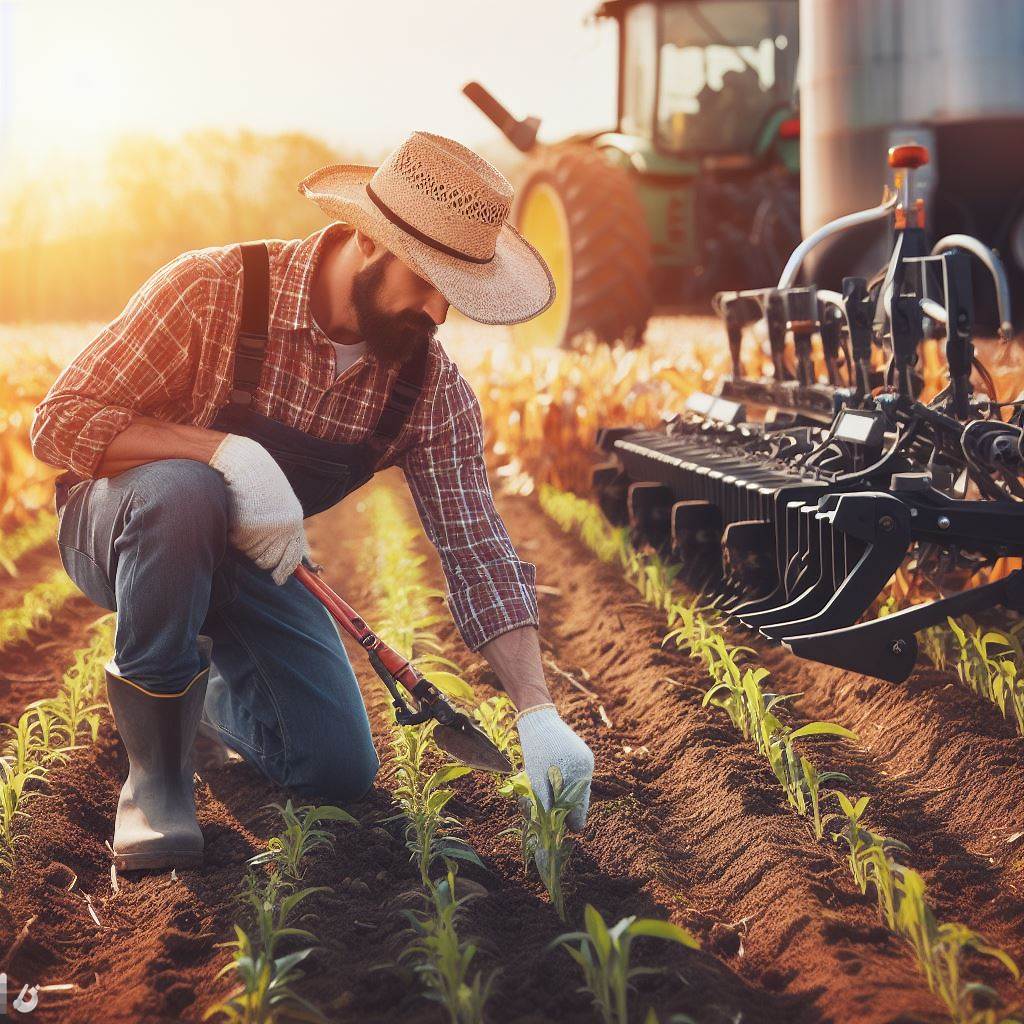Introduction
Explore drip irrigation—a water-saving method in crop fields that actively conserves water while promoting efficient agricultural practices.
Water scarcity is a pressing issue worldwide, with agriculture being one of the major consumers.
Efficient irrigation methods are imperative to conserve water and ensure sustainable farming practices.
In this section, we will explore the significance of saving water in crop fields and introduce the remarkable technique of drip irrigation.
Water is indispensable for crop growth, yet its scarcity threatens food production, especially in arid regions.
Saving water in crop fields is crucial to sustain agriculture, preserve ecosystems, and alleviate water stress on communities.
Efficient water management can support food security and mitigate environmental impacts.
Imagine a scenario where fields flourish with bountiful crops while using significantly less water.
This remarkable feat is made possible through the revolutionary technique of drip irrigation.
Unlike conventional methods, drip irrigation offers precision, resource efficiency, and improved yields.
Let’s delve into its wonders and discover its potential to revolutionize farming practices.
What is Drip Irrigation?
A. Definition of drip irrigation
Drip irrigation is a type of watering system that delivers water directly to the base of plants.
B. Explanation of how it differs from traditional irrigation methods
Drip irrigation uses a network of tubes and emitters to deliver water precisely to plant roots.
Traditional irrigation methods often involve overhead sprinklers that water the entire field.
C. Benefits of using drip irrigation in crop fields
- Water conservation: Drip irrigation reduces water wastage as water is delivered directly to plants, minimizing evaporation.
- Improved plant health: By delivering water directly to the roots, plants receive a consistent and adequate water supply for optimal growth.
- Increased crop yield: Drip irrigation helps to maintain soil moisture levels, ensuring plants have access to water whenever they need it.
- Weed control: Since water is applied only to the plant roots, weeds are less likely to grow and compete for water and nutrients.
- Fertilizer efficiency: Drip irrigation allows for precise application of fertilizers, minimizing runoff and nutrient wastage.
- Energy savings: Drip irrigation requires lower water pressure compared to traditional methods, reducing energy consumption.
- Soil erosion prevention: The slow and steady release of water from emitters minimizes soil erosion, preserving the topsoil.
- Disease prevention: By avoiding wet foliage, drip irrigation reduces the spread of diseases caused by fungal pathogens.
D. Implementing a drip irrigation system in crop fields requires careful planning and execution
- Site assessment: Understand the field’s topography, soil type, and crop requirements to design an efficient system.
- Selection of components: Choose appropriate tubes, emitters, filters, and valves based on the field’s requirements.
- Design and layout: Create a layout with proper spacing and placement of tubes and emitters to ensure uniform water distribution.
- System installation: Dig trenches, lay out the tubing network, connect emitters, and install the main supply line and filtration system.
- System maintenance: Regularly check for leaks, clogs, and damaged emitters. Flush the system regularly to prevent clogging.
- Monitoring and adjustments: Monitor soil moisture levels, plant health, and water pressure, making necessary adjustments to the system.
Furthermore, governments and agricultural organizations can play a crucial role in promoting the adoption of drip irrigation:
Transform Your Agribusiness
Unlock your farm's potential with expert advice tailored to your needs. Get actionable steps that drive real results.
Get Started- Providing financial incentives: Governments can offer subsidies or grants to farmers for installing drip irrigation systems.
- Education and training: Conduct workshops and training programs to educate farmers about the benefits and proper use of drip irrigation.
- Research and development: Invest in research to develop more efficient and cost-effective drip irrigation technologies.
- Awareness campaigns: Spread awareness about drip irrigation through media, farming conferences, and community outreach programs.
In fact, drip irrigation offers numerous benefits to crop fields, including water conservation, improved plant health, and increased crop yield.
By implementing drip irrigation systems and promoting their adoption, we can ensure sustainable and efficient water usage in agriculture.
Let’s embrace this technology and contribute to a greener future.
How Does Drip Irrigation Work?
A. Overview of the components involved in drip irrigation system
- Main water source: Drip irrigation systems are connected to a reliable water source, such as a well or a reservoir.
- Water pump: A pump is required to push the water through the system and maintain the desired pressure.
- Filters: Filters are essential to remove any debris, sediments, or impurities from the water before it enters the irrigation lines.
- Pressure regulator: This component ensures that the water pressure remains constant to prevent damage to the emitters and ensure even water distribution.
- Control valves: Valves regulate the flow of water and enable the system to be split into different zones for efficient watering.
- Polyethylene tubing: The main distribution lines are made of flexible, durable, and UV-resistant tubing that carries the water to the desired locations.
B. How water is delivered directly to the plant’s root zone through small tubes or emitters
- Emitters or drippers: These are small devices installed directly at the base of each plant that deliver water at a slow and steady rate.
- Pressure-compensating emitters: These emitters ensure that each plant receives the same amount of water, regardless of its location or elevation.
- Micro-sprinklers: In addition to emitters, micro-sprinklers can be used to provide supplemental water to larger plants or for germination purposes.
- Precision placement: Emitters are strategically placed near the root zone of each plant to minimize water loss and maximize efficiency.
- Water absorption: The slow and targeted water application allows plants to absorb moisture more effectively, minimizing evaporation and runoff.
C. Importance of proper design and installation for effective water distribution
- Water efficiency: Proper design and installation ensure that water is delivered precisely where it is needed, minimizing wastage.
- Increased crop yield: Drip irrigation promotes healthier plant growth and higher crop yields due to consistent and optimal water supply.
- Weed control: Drip irrigation delivers water directly to the root zone, minimizing moisture on the soil surface and reducing weed growth.
- Reduced disease risk: By avoiding overhead watering, drip irrigation helps to prevent the spread of diseases caused by fungal pathogens.
- Nutrient management: Drip irrigation allows for precise application of fertilizers and nutrients directly to the root zone, enhancing plant nutrition.
- Soil erosion prevention: By providing water directly to the plants’ root zones, drip irrigation minimizes soil erosion caused by runoff.
In essence, drip irrigation is an efficient and sustainable method of watering crop fields.
Its components, such as filters, tubing, and emitters, work together to deliver water directly to the plant’s root zone.
Proper design and installation are crucial for maximizing water efficiency and achieving optimal crop yields.
By implementing drip irrigation systems, farmers can save water, increase productivity, and contribute to a more sustainable agricultural future.
Read: Effective Weed Control in Crop Cultivation
Advantages of Drip Irrigation
A. Water Conservation
Drip irrigation is a water-efficient method that helps in conserving water in crop fields.
Unlike traditional sprinkler irrigation, where water is sprayed over the entire field, drip irrigation delivers water precisely to the plant’s roots.
This targeted approach saves water by minimizing wastage through evaporation, runoff, and deep percolation.
In drip irrigation, small tubes or emitters are placed near the base of the plants, supplying water directly to the root zone.
As the water is applied slowly and close to the surface, it has more time to soak into the soil and be absorbed by the plants.
This controlled delivery system ensures that water is only supplied where it’s needed, reducing overwatering and water loss.
Another aspect of water conservation in drip irrigation is the ability to regulate the flow rate and schedule of water application.
Farmers can adjust the drip system to provide the optimal amount of water required by different crops at various growth stages.
This precise control helps in minimizing water usage and improving irrigation efficiency.
B. Improved Crop Health
Controlling water application is vital for maintaining crop health, and drip irrigation excels in this aspect.
By delivering water directly to the roots, drip irrigation keeps the foliage dry, preventing the development and spread of fungal diseases.
Diseases like powdery mildew and leaf blight, which thrive in humid environments, are minimized with drip irrigation.
Additionally, drip irrigation significantly reduces weed growth.
Since water is delivered only to the plant’s root zone, weed seeds on the soil surface receive minimal moisture, hindering their germination and growth.
This reduces the competition for nutrients and sunlight between the crop plants and weeds, resulting in healthier crops with fewer weed-related issues.
C. Increased Crop Yield
Drip irrigation plays a crucial role in promoting healthy plant growth and increasing crop yield.
Showcase Your Farming Business
Publish your professional farming services profile on our blog for a one-time fee of $200 and reach a dedicated audience of farmers and agribusiness owners.
Publish Your ProfileThe continuous supply of water and nutrients directly to the root zone ensures that the plants receive the ideal conditions for growth.
The roots can uptake water and nutrients efficiently, leading to more vigorous plant development and improved yields.
Moreover, drip irrigation allows farmers to closely manage the nutrient levels in the soil.
Fertilizers can be easily incorporated into the irrigation system, ensuring that the plants receive the required nutrients in the right quantities.
This precise nutrient delivery helps in maximizing plant growth, enhancing productivity, and improving the overall quality of the crops harvested.
In general, drip irrigation offers several advantages in crop fields.
It conserves water by delivering it precisely to the plants’ roots, reducing wastage. It also improves crop health by minimizing disease incidence and weed growth.
Additionally, drip irrigation promotes increased crop yield through optimal water and nutrient supply.
Adopting drip irrigation can significantly contribute to sustainable agriculture and resource conservation.
Read: Soil pH and Its Impact on Crop Growth

Environmental Benefits of Drip Irrigation
Drip irrigation is a highly efficient method of watering crops that offers numerous environmental benefits.
This irrigation technique, which involves delivering water directly to the base of plants, has gained popularity in recent years due to its ability to conserve water resources and minimize soil erosion.
A. Reduced Soil Erosion
One of the significant environmental benefits of drip irrigation is its impact on soil erosion.
Traditional irrigation methods often lead to runoff, which carries away topsoil and nutrients, causing erosion.
Drip irrigation, on the other hand, releases water slowly and precisely at the plants’ root zones, preventing runoff and reducing soil erosion.
This helps maintain the soil’s fertility and structure, ensuring sustainable agricultural practices.
B. Conservation of Water Resources
The conservation of water resources is another crucial advantage offered by drip irrigation.
This method delivers water directly to the plants, minimizing evaporation and wastage.
Unlike overhead sprinkler systems, which tend to lose significant amounts of water due to evaporation and wind drift, drip irrigation ensures that water is efficiently utilized by the crops.
This not only saves water but also reduces the strain on local water sources, ultimately promoting sustainable water management.
C. Prevents Nutrient Leaching
In addition to conserving water, drip irrigation also plays a vital role in preventing nutrient leaching.
Traditional irrigation techniques often lead to the excess application of fertilizers, which can migrate into groundwater, polluting water sources.
Drip irrigation, however, efficiently delivers nutrients directly to the roots, ensuring that plants receive the required nutrients while minimizing leaching.
By reducing nutrient losses and optimizing nutrient uptake by plants, drip irrigation promotes sustainable farming practices and protects water quality.
The environmental benefits of drip irrigation extend beyond water conservation and preventing soil erosion.
This method also facilitates better control over irrigation scheduling, reducing the need for excessive water use.
By providing water only when and where it is needed, farmers can avoid overwatering, which can lead to waterlogged soil and adversely affect plant health.
Moreover, drip irrigation also helps in weed control, as the soil surface remains dry, inhibiting weed germination and growth.
This reduces the need for herbicides, contributing to a healthier agricultural ecosystem.
Furthermore, drip irrigation promotes overall sustainability by reducing energy consumption and greenhouse gas emissions.
Compared to traditional irrigation systems, which often require significant amounts of energy for pumping and distribution, drip irrigation operates at lower pressure and utilizes less energy.
This not only reduces carbon emissions but also makes farming more cost-effective.
In a nutshell, drip irrigation offers significant environmental benefits for crop fields.
From reducing soil erosion and conserving water resources to preventing nutrient leaching and promoting sustainable farming practices, this irrigation technique plays a crucial role in preserving the environment and ensuring the long-term viability of agriculture.
By adopting drip irrigation, farmers can contribute to water conservation, protect soil quality, and ultimately create a more sustainable future for farming.
Read: Cotton Cultivation: Best Practices and Tips
Challenges and Limitations of Drip Irrigation
A. Initial setup cost
Installing a drip irrigation system can be expensive for farmers due to various factors.
Firstly, the cost of purchasing the necessary equipment such as tubing, emitters, filters, and pressure regulators can be substantial.
Additionally, the installation process requires skilled labor, which adds to the overall expense.
Moreover, farmers may also need to invest in a proper water source, such as a well or a storage tank, to ensure a continuous water supply.
Showcase Your Farming Business
Publish your professional farming services profile on our blog for a one-time fee of $200 and reach a dedicated audience of farmers and agribusiness owners.
Publish Your ProfileB. Regular monitoring and maintenance requirements
Drip irrigation systems demand consistent monitoring and maintenance to guarantee their efficient functioning.
The narrow passageways of the emitters are prone to clogging, which can disrupt the water flow and potentially damage the crops.
Farmers need to regularly inspect the system, clean the filters, and remove any debris that may accumulate, ensuring optimum performance.
Ignoring maintenance can result in reduced water flow and uneven distribution, leading to inefficient water usage and potentially harming crop growth.
C. Limited applicability
While drip irrigation is a highly efficient method for water conservation, it may not be suitable for all crops and situations.
Certain crops, such as rice or cranberries, require constant flooding, making drip irrigation impractical.
Similarly, rocky or uneven terrains may hinder the installation of a drip system, rendering it ineffective.
Additionally, crops that require frequent soil flushing, like lettuce or spinach, might not benefit from it as the water movement is relatively shallow.
Overall, despite its numerous advantages, drip irrigation faces certain limitations and challenges that farmers must consider before deciding to implement this irrigation method.
The initial setup cost can be a significant barrier for many farmers, requiring a substantial investment in equipment and labor.
Moreover, regular monitoring and maintenance are essential to prevent clogging and ensure the system’s optimal performance.
Furthermore, while drip irrigation is highly effective for most crops, it may not be suitable or practical in certain situations due to specific crop requirements or terrain conditions.
It is important for farmers to carefully evaluate the limitations and challenges of drip irrigation, taking into account their specific needs and resources.
Proper planning, budgeting, and training can help overcome some of these challenges, making drip irrigation a viable and sustainable solution for water conservation in crop fields.
Read: Integrated Pest Management for Fruit Trees
Case Studies and Success Stories
A. Examples of successful implementation of drip irrigation in various crop fields
Implementing drip irrigation has shown remarkable success in various crop fields around the world.
- A cotton farmer in California increased water efficiency by 50% and achieved higher crop yields.
- Vineyard owners in Italy reduced water consumption by 40% and improved grape quality.
- Vegetable farmers in India minimized water wastage and experienced higher profitability.
B. Testimonials from farmers who have realized significant water savings and improved crop yields through drip irrigation
- Farmers who have adopted drip irrigation share their positive experiences and outcomes.
- John, a corn farmer, saved 30% on water usage and saw significant yield improvements.
- Maria, an orchard owner, witnessed healthier trees and reduced water bills after switching to drip irrigation.
- Ahmed, a wheat farmer, expressed satisfaction with improved water conservation and increased profits.
These success stories and testimonials demonstrate the benefits of drip irrigation in crop fields:
- Water Efficiency: Drip irrigation reduces water usage by delivering water directly to plant roots.
- Improved Crop Yields: The controlled water supply enhances plant growth, leading to higher productivity.
- Cost Savings: Farmers can reduce costs associated with water usage and increase their profitability.
- Environmental Impact: It minimizes water wastage, conserving a precious natural resource.
- Adaptability: It techniques can be customized to suit different crops and field conditions.
In summary, drip irrigation has proven to be a successful method of saving water in crop fields.
By sharing case studies, success stories, and testimonials, we have seen the tangible benefits experienced by farmers worldwide.
It is not only an effective solution for water conservation but also contributes to increased crop yields.
With its numerous advantages, drip irrigation is a sustainable practice that should be widely adopted in agriculture.
Find Out More: Organic Pest Control: Myths & Facts
Conclusion
Water conservation in crop fields is of utmost importance. The recap highlights the significance of conserving water in agriculture.
The imperative of water conservation in crop fields cannot be overstated.
The vitality of water as a finite resource demands a conscientious approach.
Recapitulating the journey, we emphasize the pivotal role played by efficient water management in securing agricultural sustainability.
Drip irrigation, with its precise and targeted water delivery, emerges as a beacon of hope in this endeavor. The benefits are manifold:
It minimizes water wastage, ensuring that every drop contributes to crop nourishment.
Plants thrive with consistent moisture, promoting healthier and more robust crop yields.
By reducing water usage, drip irrigation aligns with environmental stewardship, preserving this vital resource for future generations.
Drip irrigation is reinforced as an effective water-saving solution with numerous benefits.
It is encouraged for farmers to explore and embrace drip irrigation for their fields to enhance water efficiency and sustainability.
As we reinforce the advantages of drip irrigation, we extend a fervent encouragement to farmers.
Explore the potential, embrace innovation, and consider adopting drip irrigation—a transformative solution for sustainable water use in crop fields.
Together, let’s cultivate a future where productivity and environmental responsibility harmoniously coexist.




